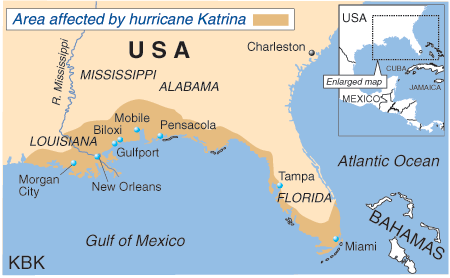






Hurricane Katrina makes landfall near New Orleans, Louisiana, as a Category 3 hurricane on August 29, 2005. Despite being only the third most powerful storm of the 2005 hurricane season, Katrina was among the worst natural disasters in the history of the United States. In the wake of the storm, there were over 50 failures of the levees and flood walls around New Orleans and its suburbs. The levee and flood wall failures caused widespread flooding.
After briefly coming ashore in southern Florida on August 25 as a Category 1 hurricane, Katrina gained strength before slamming into the Gulf Coast on August 29. In addition to bringing devastation to the New Orleans area, the hurricane caused damage along the coasts of Mississippi and Alabama, as well as other parts of Louisiana.
New Orleans Mayor Ray Nagin ordered a mandatory evacuation of the city on August 28, when Katrina briefly achieved Category 5 status and the National Weather Service predicted “devastating” damage to the area. But an estimated 150,000 people, who either did not want to or did not have the resources to leave, ignored the order and stayed behind. The storm brought sustained winds of 145 miles per hour, which cut power lines and destroyed homes, even turning cars into projectile missiles. Katrina caused record storm surges all along the Mississippi Gulf Coast.
The surges overwhelmed the levees that protected New Orleans, located at six feet below sea level, from Lake Pontchartrain and the Mississippi River. Soon, 80 percent of the city was flooded up to the rooftops of many homes and small buildings.
Tens of thousands of people sought shelter in the New Orleans Convention Center and the Louisiana Superdome. The situation in both places quickly deteriorated, as food and water ran low and conditions became unsanitary. Frustration mounted as it took up to two days for a full-scale relief effort to begin. In the meantime, the stranded residents suffered from heat, hunger, and a lack of medical care.
Reports of looting, rape and even murder began to surface. As news networks broadcast scenes from the devastated city to the world, it became obvious that a vast majority of the victims were African American and poor, leading to difficult questions among the public about the state of racial equality in the United States. The federal government and President George W. Bush were roundly criticized for what was perceived as their slow response to the disaster. The head of the Federal Emergency Management Agency (FEMA), Michael Brown, resigned amid the ensuing controversy.
Finally, on September 1, the tens of thousands of people staying in the damaged Superdome and Convention Center begin to be moved to the Astrodome in Houston, Texas, and another mandatory evacuation order was issued for the city. The next day, military convoys arrived with supplies and the National Guard was brought in to bring a halt to lawlessness. Efforts began to collect and identify corpses. On September 6, eight days after the hurricane, the Army Corps of Engineers finally completed temporary repairs to the three major holes in New Orleans’ levee system and were able to begin pumping water out of the city.
In all, it is believed that the hurricane caused more than 1,800 deaths and up to $150 billion in damages to both private property and public infrastructure. One million people were displaced by the disaster, a phenomenon unseen in the United States since the Great Depression. Four hundred thousand people lost their jobs as a result of the disaster. Offers of international aid poured in from around the world, even from poor countries like Bangladesh and Sri Lanka. Private donations from U.S. citizens alone approached $600 million.
The storm also set off 36 tornadoes in Mississippi, Alabama, Georgia, Pennsylvania, and Virginia, resulting in one death.
President Bush declared September 16 a national day of remembrance for the victims of Hurricane Katrina.
In a 2006 federal report, the U.S. Army Corps of Engineers admitted that the flood-control complex surrounding New Orleans had been incomplete, insufficient and improperly maintained. “The hurricane protection system in New Orleans and southeast Louisiana was a system in name only,” said the report.
It is my sincere desire to provide readers of this site with the best unbiased information available, and a forum where it can be discussed openly, as our Founders intended. But it is not easy nor inexpensive to do so, especially when those who wish to prevent us from making the truth known, attack us without mercy on all fronts on a daily basis. So each time you visit the site, I would ask that you consider the value that you receive and have received from The Burning Platform and the community of which you are a vital part. I can't do it all alone, and I need your help and support to keep it alive. Please consider contributing an amount commensurate to the value that you receive from this site and community, or even by becoming a sustaining supporter through periodic contributions. [Burning Platform LLC - PO Box 1520 Kulpsville, PA 19443] or Paypal
-----------------------------------------------------
To donate via Stripe, click here.
-----------------------------------------------------
Use promo code ILMF2, and save up to 66% on all MyPillow purchases. (The Burning Platform benefits when you use this promo code.)





Notice we have made through August without one hurricane and not even a tropical storm. If we make it through September the weather predictors are going to look stupid. I’m pretty sure I remember them predicting a “more active than usual” hurricane season.
Jim Cantore thought he was in real trouble of drowning, to the best of my memory.
I met the NO EMA Director at a Fed EMA magement class in Maryland a few weeks prior to the storm. Talking during a break in class he assured me they were a 100% ready for even a Camille sized storm. I grew up on the Gulf Coast and took that with a grain of salt. I’m sure no one got fired.
The Mississippi River Gulf Outlet, aka MR GO, was a vital component in allowing storm surge from Katrina easy and unfettered access to Lake Borgne and Lake Ponchatrain, and subsequently overwhelming the wimpy storm protection offered. The Army Corps of Engineers was finally embarrassed into closing off that passage… like closing the barn door AFTER the horses have bolted.
Shell Beach, near Bayou Yscloskey in St. Bernard Parish, was once a brackish shore on Lake Borgne composed of lots of little white shells from the crustaceans that used to thrive there. When MR GO was opened up for NASA to transport spent Solid Rocket Booster Engines for refit in Mississippi, the brackish water of Lake Borgne became inhospitable to the little clams to whom Shell Beach owes its name.
Safe and navigable waters are critical, as are reliable nautical charting, for a country to have success with import, export, and even simple recreation. The US Army Corps of Engineers does “yeoman’s service” in many areas of insuring safe navigational operations for which they deserve much credit.
The US Army Corps of Engineers, USACE, also has its fingers in all sorts of sediment diversion programs. Some of them are indisputably necessary for commerce, like the dredging of the Mississippi River main channel and the Intracoastal Waterway systems, to name a couple.
But, when this agency starts to divert massive flows of sediment-rich freshwater from the heartland of America, I have to wonder at their qualifications based on their track record alone.
Edit: USACE commentary expansion
katrina was what allowed the deep state to knock bush off his agenda & sabotage his presidency–
there are a couple of systems that need to be watched,esp 4 you guys on the east coast–